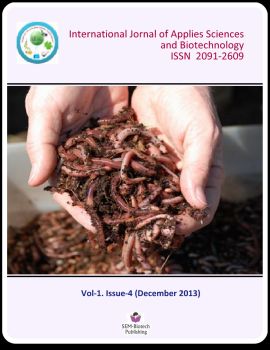Decolourization of Orange G Dye by Microalgae Acutodesmus obliquues Strain PSV2 Isolated from Textile Industrial Site
DOI:
https://doi.org/10.3126/ijasbt.v1i4.9141Keywords:
Microalgae, Acutodesmus oliques strain PSV 2, Orange G dye, Absorption, IsothermsAbstract
Introduction-Release of different types of synthetic dyes into the aquatic environment by various industrial sources is a major area of concern worldwide due to their low biodegradable nature. Conventional methods of dye removal are effective but high operating cost and energy requirement, generation of toxic sludge and regeneration problem of adsorbent limits their use at large scale. Biosorption of dye molecules by microorganisms is an economic and eco friendly technology for the treatment of textile wastewater.
Aims & objective-The study was carried out to isolate microalgae from industrial site and to evaluate its efficiency for adsorption of Orange G dye from aqueous solution.
Materials and methods- A unicellular green micro alga was isolated from textile and dye contaminated site of Sanganer, Jaipur (India) .Biosorption studies were conducted in a batch system for the removal of orange G dye from aqueous solution. Different parameters of pH, time, and initial dye concentration were investigated to optimize the process. Kinetic and equilibrium isotherms were implemented to experimental data in order to investigate the mechanism of biosorption.
Results- Microalgae isolated from industrial site was found to be highly efficient for absorption of Orange G dye from aqueous solution. Batch studies depicts that Acutodesmusobliquues strain PSV 2 can absorb orange G dye at optimum pH 2.0 and maximum absorption (56.49 mg/g) occurred within initial 60 min of contact time. Equilibrium studies showed that Freundlich isotherm fitted well with experimental data with high correlation coefficient (r2=0.995) and n value (n=1.192). Langmuir isotherm showed r2=0.96 and value of b=0.008, which represents favorable adsorption of dye on algal surface. FTIR analysis of adsorbent before and after dye adsorption showed the involvement of some functional groups in dye absorption.
DOI: http://dx.doi.org/10.3126/ijasbt.v1i4.9141
Int J Appl Sci Biotechnol, Vol. 1(4): 247-252




